Genetic Inheritance
Genetic Inheritance Revision
Genetic Inheritance
Offspring inherit different sets of chromosomes and alleles from their parents which cause different traits to be expressed. The probability of offspring having specific traits or being a certain sex can be worked out using punnet squares. Mendel conducted a very important set of experiments using pea plants and observed how different characteristics are passed on to descendants.
Key Terminology
In this topic it is essential that you learn and understand the key terms:
- DNA is a molecule found in the nucleus of cells that holds the genetic information of an organism.
- Chromosomes are structures that are made of DNA. In meiosis, chromosomes duplicate then get divided up into gametes.
- Gametes are sex cells (in animals they are called egg cells and sperm, in plants they are called egg cells and pollen). They fuse together in fertilisation as part of sexual reproduction.
- Genes are lengths of DNA on chromosomes that code for specific proteins.
- Alleles are different versions of the same gene. Individuals will inherit an allele for each gene from their mother and their father.
- Alleles are dominant if they are always expressed, even if there is only one copy. They are written using capital letters.
- Alleles are recessive if they are only expressed when there is two copies (no dominant alleles). They are written using lowercase letters.
- Homozygous individuals have 2 alleles that are the same, e.g. BB or bb.
- Heterozygous individuals have 2 different alleles, e.g. Bb.
- The genotype is the alleles that an organism has for a specific characteristic.
- The phenotype of an organism is its observable characteristics that are determined by its genotype.
Genes and Alleles
Most characteristics are as a result of the interactions between multiple genes.
Some characteristics are controlled by individual genes (e.g. fur colour of mice, red-green colour blindness in humans). Each gene has different forms, called alleles.
The different alleles present in an organism (genotype) dictate the proteins made and therefore the characteristics expressed (phenotype).
Alleles can be recessive or dominant:
- Recessive alleles are those that are only expressed if there are two of them present (homozygous). They are notated using lowercase letters.
- Dominant alleles are those that are expressed if there is one (heterozygous) or two (homozygous) of them present. They are notated using uppercase letters.
Individuals can be homozygous or heterozygous for a specific trait:
- Homozygous individuals have 2 of the same alleles for a gene (e.g. AA or aa).
- Heterozygous individuals have 2 different alleles for a gene (e.g. Aa), the dominant allele will always be expressed.
Punnett Squares
Punnet squares help to calculate the probability of offspring inheriting different traits.
Example:
Fur colour in mice is controlled by a single gene. The allele that codes for white fur is recessive and represented by a lowercase b in this example. The allele that codes for grey fur is dominant and is represented by an uppercase B in this example.
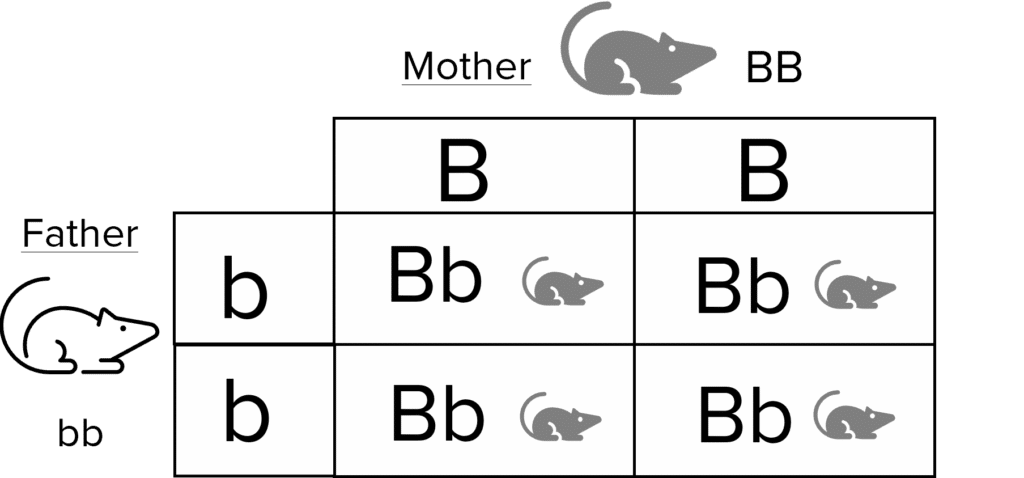
1. When a grey homozygous dominant mouse (BB) breeds with a white homozygous recessive mouse (bb), all of their offspring will be grey and will be heterozygous (Bb).
All offspring in the punnet square are grey so the probability of an offspring being grey is 100\% and probability of it being white is 0\%.
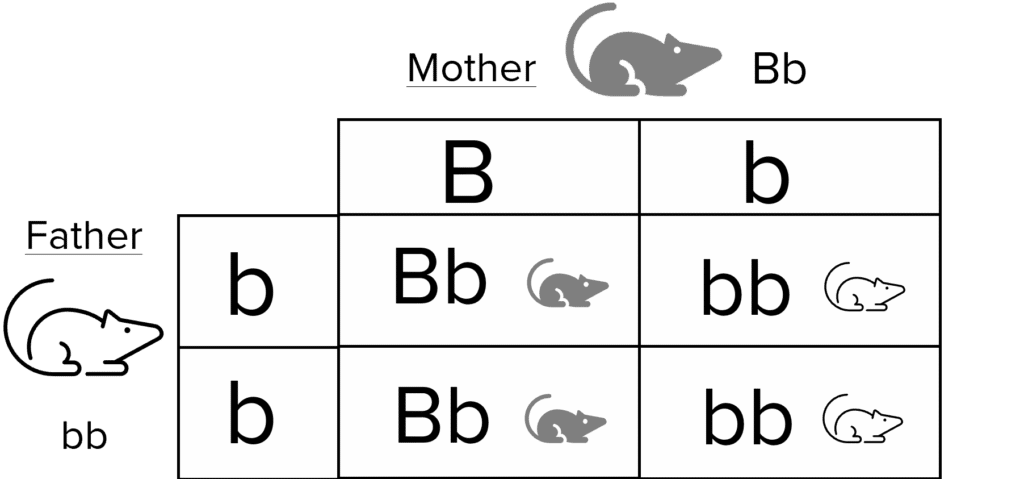
2. When a grey heterozygous (Bb) mouse breeds with a white homozygous recessive mouse (bb), there is an equal chance that the offspring will be grey heterozygous (Bb) and being white homozygous (bb).
2 out of 4 boxes have white offspring, 2 out of 4 boxes have grey offspring. There is a 50\% chance of the offspring being grey and a a 50\% chance of the offspring being white. The ratio of white to grey mice is 1:1.
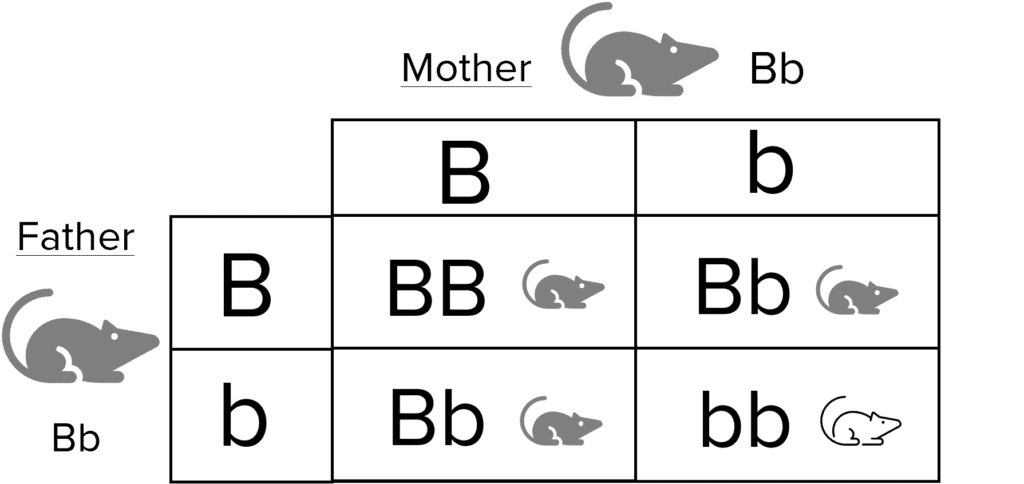
3. When a grey heterozygous mouse (Bb) breeds with another grey heterozygous mouse (Bb), there is a 25\% chance of the offspring being homozygous grey (BB), a 25\% chance of the offspring being homozygous white (bb) and a 50% of the offspring being grey and heterozygous (Bb).
3 out of the 4 boxes show grey offspring and 1 out of the 4 boxes show white offspring. Overall, the chance having of grey offspring is 75\% and the chance of having white offspring is 25\%. The ratio of white to grey mice is 1:3.
Note:
In the exam, you may be asked to complete and interpret different punnet square diagrams.
Higher tier students may also be asked to construct them from scratch and use them to make predictions about the probability of traits being expressed in the offspring.
Mendel’s Pea Plant Experiments
Gregor Mendel was a monk who first began to track patterns of inheritance in pea plants in the mid 19^\text{th} century. He published his results and they become a foundation for further genetic investigations.
One of his investigations looked at the inheritance of height:
- He crossed a tall pea plant with a dwarf pea plant and found that all the offspring were tall.
- Then he crossed two of the tall offspring together and found that they produced three tall pea plants and one dwarf pea plant.
- He concluded that height is determined by ‘hereditary units‘ passed on from the parents and that the unit for tall plants was dominant over the unit for dwarf plants.
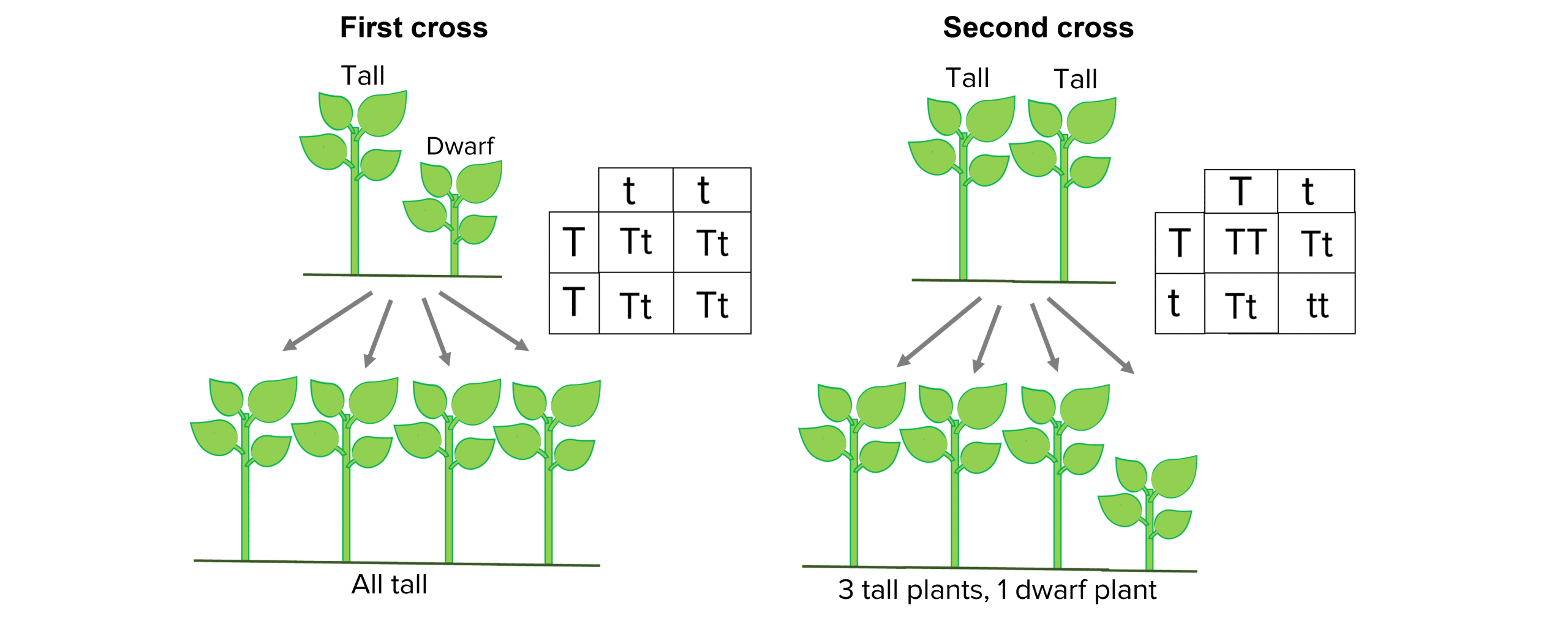
Scientists of the day struggled to understand Mendel’s work because it was very new and they had no knowledge of the subject. It wasn’t until after his death that his work was recognised.
At the start of the 20^\text{th} century, scientists noticed that chromosomes behaved in a similar way to Mendel’s ‘hereditary units‘. This led to the conclusion that Mendel’s ‘hereditary units‘ (which we now call genes) are found on the chromosomes.
In the mid 20^\text{th} century, scientists determined the structure of DNA which further expanded our knowledge of how genes work.
Sex Determination
Human body cells have 23 pairs of chromosomes.
22 of the pairs control characteristics in the organism and the remaining pair determines the sex.
Females have two X chromosomes (XX).
Males have an X chromosome and a Y chromosome (XY).
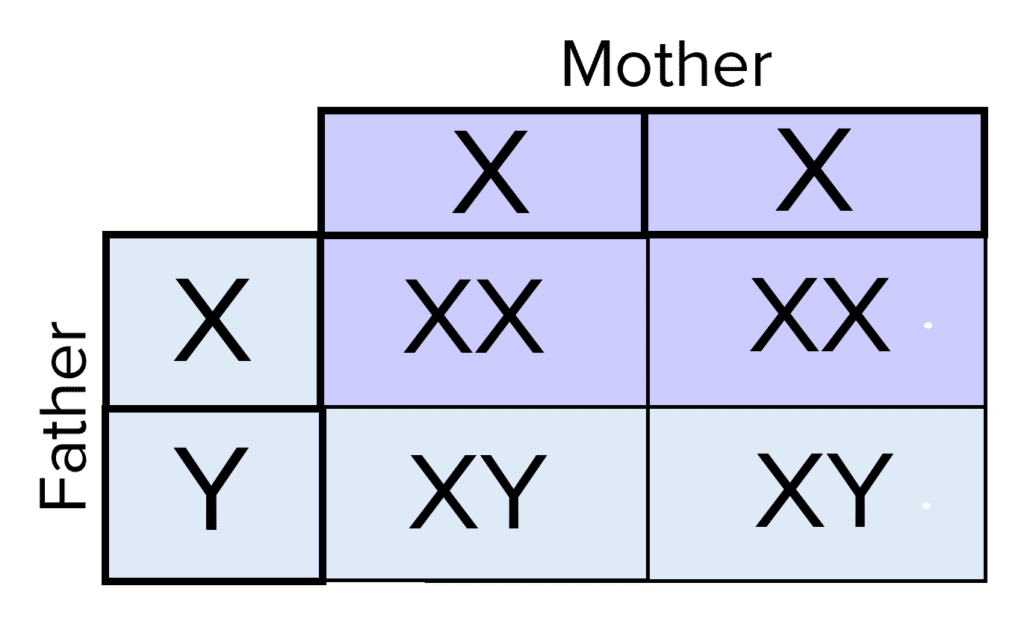
In males, when sperm are made in meiosis, the X and the Y chromosomes get separated into different gametes. This means there is a 50\% chance that a sperm has an X chromosome and and 50\% chance that a sperm has a Y chromosome.
As females have two X chromosomes, all egg cells contain an X chromosome.
All zygotes will have an X chromosome from the mother and either an X or Y chromosome from the father. This dictates the sex of the offspring.
Genetic crosses or punnet squares can be made to show this inheritance.
Genetic Inheritance Example Questions
Question 1: Define the terms allele, homozygous and phenotype.
[3 marks]
Allele – Different forms of the same gene.
Homozygous – Has two alleles that are the same.
Phenotype – Observable characteristics that are determined by the genotype.
Question 2: Fur colour in rabbits is determined by a single gene. The dominant allele, ‘B’, causes the fur to be brown, the recessive allele, ‘b’, causes the fur to be white.
A white female rabbit breeds with a brown heterozygous male rabbit. Draw a punnet square and calculate the probability of an offspring’s fur being brown.
[3 marks]
Punnet Square:
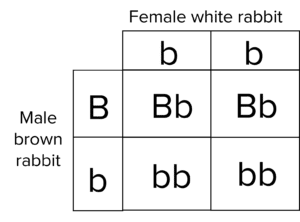
1 mark for the correct parent genotypes, 1 mark for the correct offspring genotypes.
There is a 50\% chance of an offspring’s fur being brown / 2 in 4 / 1:1.
Question 3: Describe the genetic difference between male and females.
[2 marks]
Males have an X and a Y chromosome.
Females have two X chromosomes.






